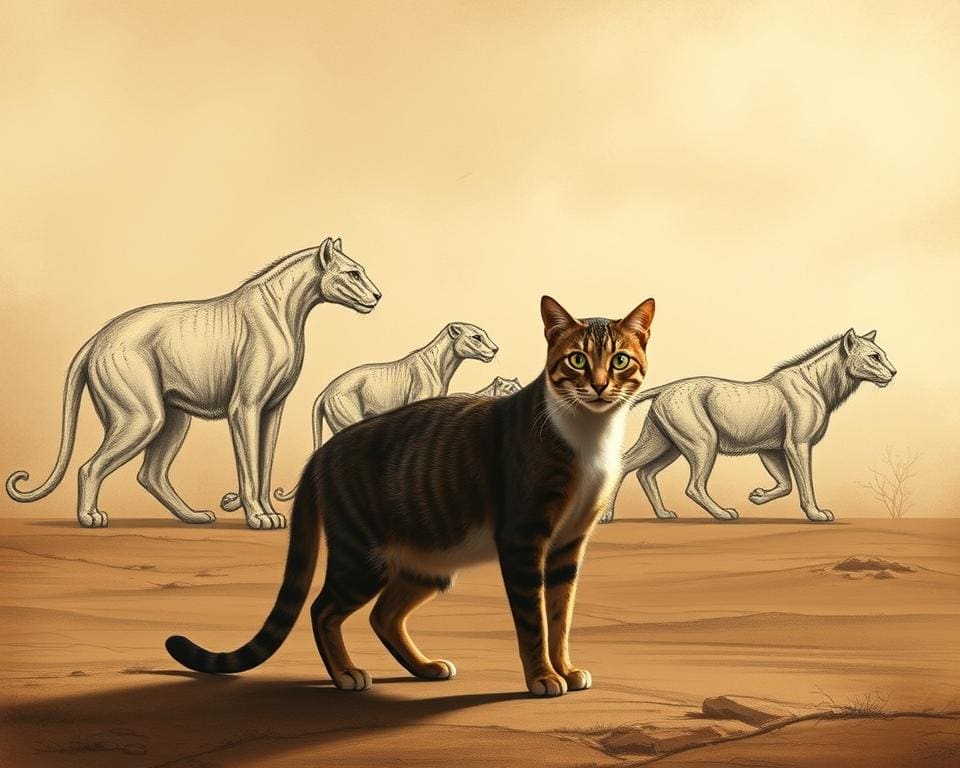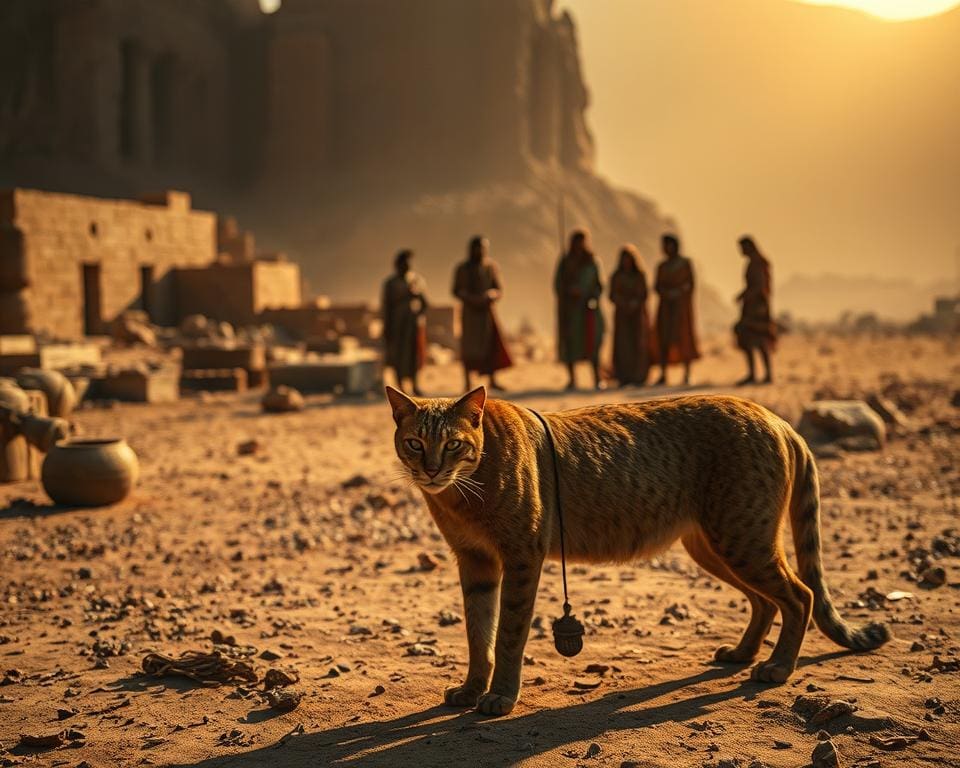The journey of house cats, timeless companions to humanity, reveals a rich tapestry of evolution and adaptation. Understanding where domestic cats originate from is essential to appreciating their role in our lives today. These fascinating animals have a lineage that traces back to wild ancestors, reflecting a remarkable transformation over the centuries. By delving into feline history, we uncover the significant ways in which cats have not only adapted to human environments but have also become cherished members of many households across the United Kingdom.
The Fascinating Journey of Domestic Cats
The evolution of domestic cats represents a captivating odyssey that intertwines closely with human history. Starting as wild creatures, these felines gradually forged bonds with humans, changing both species profoundly over time. The process of their domestication provides a window into the remarkable adaptability and resilience of these animals, which have now become cherished companions in countless households.
Understanding Their Evolution
Through centuries, domestic cats have undergone significant transformations that reflect their surroundings and interactions with humans. *Feline history* reveals that the earliest ancestors of today’s domestic cats, the African wildcat, exhibited traits that enhanced their survival alongside humans. These adaptations raised intriguing questions about genetic changes and behavioural developments. Research indicates that certain wildcats adapted to human settlements, attracted by food sources and safety, initiating a profound shift in their evolution.
The Transition from Wild to Tame
The movement from wild felines to beloved pets involved a complex blend of natural and artificial selection. Traits such as sociability and reduced aggression positioned some cats better for integration into human environments. Observations across generations showcase how traits favourable for coexistence emerged, leading to the domestic cats we know today. Archaeological findings support these insights, highlighting the earliest interactions between humans and wildcats, marking the inception of a unique companionship.

Where Do House Cats Originate From
The origins of house cats are deeply rooted in ancient history, primarily connecting them to the African wildcat. This fascinating lineage showcases how domestic cats have evolved over thousands of years. As agriculture emerged, these felines found themselves embarking on a journey toward companionship with humans, highlighting their adaptability and significance in our lives. Understanding these feline origins offers profound insights into the complex relationship between humans and their pets.
Exploring the Ancestry of Cats
The African wildcat, a direct ancestor of the modern domestic cat, is central to understanding house cat origins. Through selective breeding and natural instinct, these wildcats started inhabiting human settlements, drawn by the abundance of rodents attracted to grain stores. This mutual benefit laid the groundwork for an enduring bond that blossomed over time, transforming wild hunters into cherished companions. The exploration of this ancestry reveals not only the biological connections but also the shifts in behaviour that have made cats such beloved members of households.
Cultural Significance of Feline Companionship
Throughout history, cats have held a prominent place in various cultures, often revered and celebrated. In ancient Egypt, they were regarded as sacred creatures, symbolising grace and protection. Artistic depictions in pottery, sculpture, and hieroglyphics illustrate the profound reverence for these animals. Beyond artistic representations, the stories and myths surrounding cats have enriched their status in society, influencing literature, folklore, and family dynamics. Their roles as companions resonate far and wide, showcasing the rich tapestry woven into domestic cat history.
Cat Evolution Throughout the Ages
The incredible journey of cat evolution reveals a complex tapestry of changes that have shaped these remarkable creatures. Through the lens of feline history, one can observe the physical and behavioural adaptations that have enabled cats to thrive alongside humans. As they transitioned from their wild ancestors, several physiological changes have emerged, reflecting the pressures of natural selection and the demands of their environments.
Tracking Changes in Cat Physiology
Over millennia, domestic cats have exhibited a variety of physiological changes. Researchers have documented shifts in size, coat patterns, and even behaviours that enhance their ability to survive in human societies. Notable variations in size, such as the reduction of body mass compared to wild cats, demonstrate how domestication has influenced these animals. Changes in coloration have mirrored their surroundings, providing better camouflage in diverse settings.
The Role of Natural Selection in Cat Development
Natural selection plays a pivotal role in cat evolution, shaping their characteristics and behaviours in response to environmental challenges. Successful prey-catching techniques underscore the efficiency of feline hunters, whilst social behaviours have evolved to promote cooperative living conditions with humans. Understanding these elements reveals how cats have adapted not only to survive but excel in their roles as beloved companions, forever entwined in our lives.
Cat Ancestors and Their Influence
The journey from wildcat to the cherished domestic cats we know today involves fascinating species and adaptations. Understanding the cat ancestors provides insight into the traits that define modern feline companions. Notably, wildcats such as the African wildcat and the European wildcat contributed significantly to the genetics of domestic cats, showcasing behaviours that remain prevalent even now.
The Wildcats That Shaped Domestic Cats
The African wildcat has played a pivotal role in the domestication process. Its hunting prowess and adaptability allowed it to thrive in human settlements, leading to the merging of its traits with those of other wildcats. The European wildcat, characterised by its distinctive coat and elusive behaviour, also contributed to the genetic pool of domestic cats. These cat ancestors exhibited traits such as agility and keen senses, essential for survival, which are still evident in domestic breeds today.
Feline Adaptations to Human Environments
As cats ventured into close quarters with humans, their behaviours evolved to facilitate coexistence. Hunting strategies shifted from wild prey to adapting to human habitats, finding new food sources while remaining adept hunters. Alongside physical adjustments, such as alterations in size and temperament, social behaviours transformed, allowing cats to form bonds with humans. These feline adaptations exemplify the intricate relationship between domestic cats and their ancestry, showcasing resilience and flexibility in a changing world.
The History of Cat Domestication
The journey of cat domestication reveals a profound bond between humans and their feline companions, shaped through centuries of interaction and adaptation. Understanding the milestones in domestic cat history provides insight into how these creatures became much more than mere pets. Their evolution from wild hunters to cherished household members marks an extraordinary transformation influenced by various key events.
Key Events in Feline History
Several significant occurrences have been instrumental in the domestication of cats. These events include:
- The agricultural revolution, which allowed the formation of permanent settlements, drew rodents that attracted wild cats.
- Human efforts to control pests around food supplies created an environment where cats found a mutually beneficial role.
- Documented interactions in ancient civilisations, particularly in Egypt, which revered cats, highlighting their esteemed status.
- Archaeological discoveries that affirm cats were kept for companionship, illustrating early forms of domestic cat history.
How Cats Became Companions
As humans and cats cohabitated, the nature of their relationship evolved. Initially valued for their hunting prowess, cats gradually transitioned into beloved companions. This shift was marked by:
- The deepening emotional connections fostered over time, leading to a recognition of cats as part of family life.
- Literary references throughout history, showcasing the companionship between cats and humans across cultures.
- Cultural practices that emphasised the protective nature of cats, with many believing they possessed mystical qualities.
Understanding Cat Breed Origins
The diverse tapestry of cat breeds we see today is a remarkable testament to the influence of human culture and geography on feline history. From the elegant Siamese, known for their striking colouration and vocal nature, to the regal Persian, celebrated for its long, luxurious fur, each breed carries unique traits that have been carefully cultivated through selective breeding. These practices not only highlight human fascination with various feline characteristics but also illustrate how different environments and customs have shaped the global variety of domestic cats.
As we delve deeper into cat breed origins, it becomes evident that each breed reflects the heritage of its wild ancestors. The natural instincts of these ancestors often persist, enabling them to thrive in close proximity to humans while retaining their innate behaviours. For example, the Bengal cat showcases a striking resemblance to its wild counterpart, the Asian leopard cat, embodying agility and a captivating appearance, thereby bridging the gap between their ancestral roots and contemporary companionship.
Modern breeding practices are an evolution of this fascinating history, with a focus on maintaining not only aesthetic qualities but also the health and genetic diversity of these beloved pets. As responsible breeders and cat enthusiasts strive to preserve the integrity of each breed, a greater awareness of their origins plays a crucial role in understanding the need for ethical practices. Recognising the rich tapestry of feline history ensures that we continue to cherish the complex relationship we share with our cats while honouring their diverse and storied lineage.









